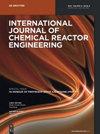Temperature sensor location for the implementation of cascade control schemes in distillation columns: an approach based on multiscale time series analysis
IF 1.6
4区 工程技术
Q3 Chemical Engineering
International Journal of Chemical Reactor Engineering
Pub Date : 2023-08-14
DOI:10.1515/ijcre-2022-0111
引用次数: 0
Abstract
Abstract In this work, the application of multiscale analysis to evaluate the sensitivity of the dynamic responses of the trays in a distillation column exposed to external disturbances is explored. This sensitivity allows for the identification of the tray where the temperature sensor improves the performance of a composition-temperature type cascade controller. To implement the proposed methodology, synthetic time series are generated for each plate of the column, which is subsequently analyzed using the multiscale rescaled range (R/S) analysis. Three case studies were evaluated (binary mixtures, azeotropic mixture and ternary mixture), finding that the highest values of the Hurst exponent correlate with the areas of greatest sensitivity of the column. To corroborate this result, a composition-temperature cascade control scheme was implemented, evaluating the temperature sensor in each plate of the column, identifying that the zone of greatest sensitivity determined with the multiscale analysis corresponds to the best performance of the controller. Therefore, our results show that the proposed methodology represents an easy-to-implement alternative that provides information on the most suitable zone for the placement of temperature sensors to improve the performance of cascade control in a pre-designed distillation column.用于实现精馏塔串级控制方案的温度传感器位置:一种基于多尺度时间序列分析的方法
摘要在这项工作中,探索了应用多尺度分析来评估蒸馏塔板在外部扰动下的动态响应灵敏度。这种灵敏度允许识别托盘,其中温度传感器提高了组成温度型级联控制器的性能。为了实现所提出的方法,为柱的每个板生成合成时间序列,随后使用多尺度重新缩放范围(R/S)分析对其进行分析。评估了三个案例研究(二元混合物、共沸混合物和三元混合物),发现赫斯特指数的最高值与柱的最大灵敏度区域相关。为了证实这一结果,实施了成分-温度级联控制方案,评估了柱的每个板中的温度传感器,确定了通过多尺度分析确定的最大灵敏度区域对应于控制器的最佳性能。因此,我们的结果表明,所提出的方法是一种易于实施的替代方案,它提供了关于最适合放置温度传感器的区域的信息,以提高预先设计的蒸馏塔中的级联控制性能。
本文章由计算机程序翻译,如有差异,请以英文原文为准。
求助全文
约1分钟内获得全文
求助全文
来源期刊
CiteScore
2.80
自引率
12.50%
发文量
107
审稿时长
3 months
期刊介绍:
The International Journal of Chemical Reactor Engineering covers the broad fields of theoretical and applied reactor engineering. The IJCRE covers topics drawn from the substantial areas of overlap between catalysis, reaction and reactor engineering. The journal is presently edited by Hugo de Lasa and Charles Xu, counting with an impressive list of Editorial Board leading specialists in chemical reactor engineering. Authors include notable international professors and R&D industry leaders.

 求助内容:
求助内容: 应助结果提醒方式:
应助结果提醒方式:


